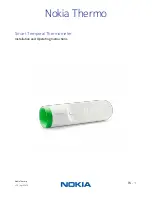
9
VST5000W5028W
Wireless Survey Tools User Guide
Please note that this ONLY applies to the initial network
start-up. Once all the devices are online to the Niagara
database, everything will operate seamlessly even on
power up / down & network re-starts.
How Orphan nodes are created in the fi eld.
Ex.:
2 small buildings are within a few feet of each other.
Both have 6+ devices / nodes / controller each (
fig.12
).
A possible cause for Building B orphan nodes is as follow:
Building A is fi rst stated and sets the Jace – coordinator
confi guration parameters for the PAN ID and Channel.
Premises:
• Building A is fi rst stated.
• Yellow device / node / controller has given out its 6
addresses out to other devices in building A.
• Building B devices / nodes / controllers can only be
connected through blue device / nodes / controller
due to maximum distance coverage.
Result:
• Because Blue controller cannot have an address
assigned by Yellow controller to join the network.
The all Orange devices / nodes / controllers cannot
join the ZigBee network either.
Getting orphan devices back on the network:
• Disconnect and bring one of the building B
device / node / controllers and power it up in
building A until it joins the ZigBee network
( confi rmed either at the Jace – coordinator
or using the status LED on the wireless
communication card of the device / node /
controller).
• When the device / node / controller has joined
the network in building A and is added to the
Niagara database, bring it back into building
B so it can propagate ZigBee addresses to the
other devices in building B.
Within Range
Jac
t t
t
t
t t
t t
t t
t t
t t
Jace
Building A
Building B
Fig. 12
5H
stands for
5
hops maximum
ANY given device / node / controller should be
“optimized”
to be
NO FURTHER
than
5 Hops
to and from
the Jace / Coordinator. This is due to the nature of the
Vykon ZigBee stack in the wireless controllers.
To properly layout the architecture and
determine the number of Jace’s required
on the job site, begin by establishing the
maximum possible coverage of a single
Jace with a wireless communication card
respecting the 5 hop maximum rule. This
can also done with the survey tools and
is covered in detail in the manual for the
survey procedures and tool usage: MAN
VWG-SURVEY-Exx.
1. Begin by positioning the Jace-coordinator centrally
in the fl oor space you are working in.
2. Find the coverage radius of the coordinator (VWG
or Jace-Driver) at its proposed location. It’s possible
that another location may improve your network
performance or that you may require an additional
coordinator ( VWG or Jace-Driver ) or additional
REP5000W wireless repeaters.
3. Set survey tool A at the proposed coordinator (VWG
or Jace-Driver)
4. With survey tool B, walk about the fl oor where a
cluster of controllers are to be found. Locate the
boundary where the signal strength is about 20%.
This represents the maximum radius of the fi rst hop
where connectivity is possible based on the building
environment and partition construction.
Please note that this distance can be anywhere from
NIL to hundreds of feet (
fig. 13
).
A
B
Jace
Coordinator
Proposed
location
Cluster of:
devices / nodes / controllers
Cluster of:
devices / nodes / controllers
20
%
Fig. 13






























